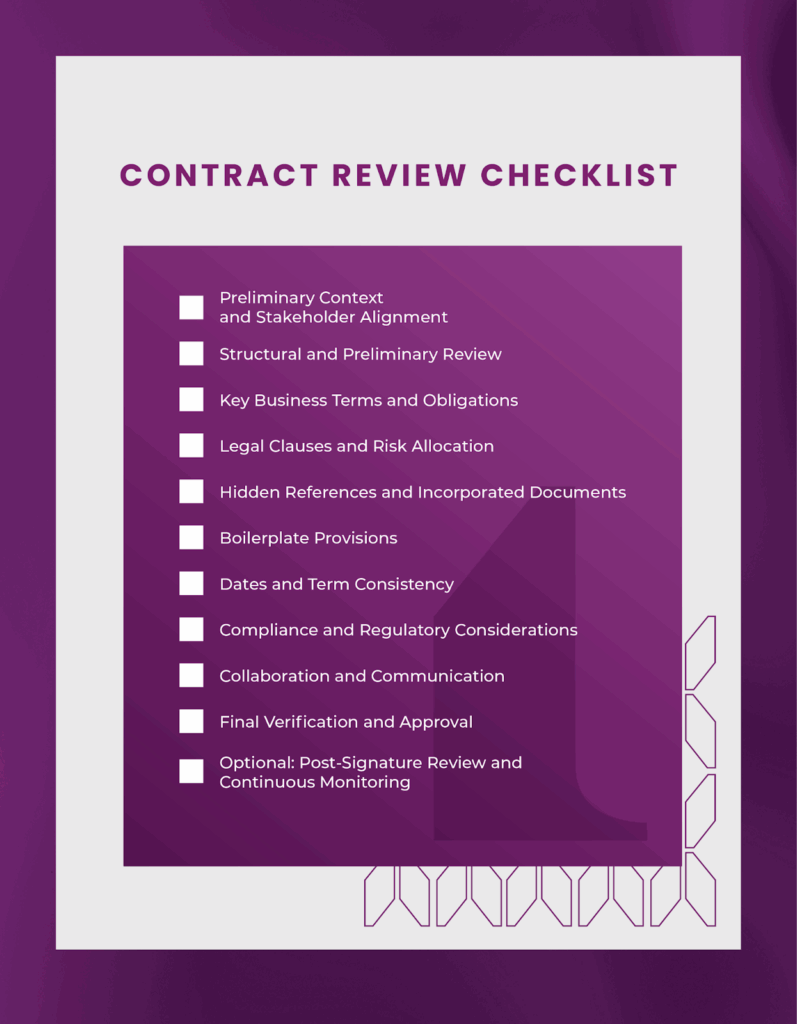7 Contract Review Tips & Complete Contract Review Checklist
Contracts are often referred to as the lifeblood of an organization, as they are the backbone that establishes and governs transactions between parties, including the buying and selling of goods and services.
Why is contract review essential to any company?
Thoroughly reviewing contracts is critical to ensure that the terms and conditions of the agreement accurately reflect the transaction contemplated by the parties. By keeping these seven tips in mind before and during your review, you can help yourself and others navigate the complex process of contract review.
Tip #1: Speak with stakeholders first.
Before looking at the agreement, speak with the key stakeholders for the transaction. Understand what the deal is intended to accomplish and, importantly, why.
Reviewing an agreement without understanding the bigger picture may lead your review astray. You may pick up on something you perceive as an issue or something concerning in the agreement when, in fact, it is not because of the context. You also want to understand from the stakeholders potentially other parties you may want to speak with about the agreement such as finance and IT.
Tip #2: Have a checklist of key issues and clauses.
Have a checklist of key issues/clauses on hand before beginning your review. This can take the form of a playbook that lays out the key positions your company takes on common provisions and potential fallback language/clauses to use if you need to end up negotiating any of these key areas. It’s common to have such a playbook or checklist incorporated into any contract review tools you may have on hand to help with your review such as a contract management solution.
Tip #3: Read through the contract from start to finish.
The purpose of the review is not to find all the potential issues in it but to understand its overall structure and flow. Reading through the entire document will also show where items are cross-referenced and give you an understanding of how specific terms are defined and used within the agreement. Reading through the entire agreement will also point out potential inconsistencies or terms that lack a definition.
Tip #4: Make collaboration easy and welcome.
When you come across issues that require input from others, help those stakeholders help you.
- Provide a simple explanation of why you need their help and what information you are seeking from them.
- Call out specific language of the agreement you need them to review or if you are emailing them, copy and paste the language into the email for their review. Everyone is busy. You want to make it easy for them to respond so they do not need to wait for you to help.
Tip #5: Watch out for “hidden” references.
Hidden references are hyperlinks or references made to other agreements or other terms that impact the agreement you are reviewing or, as sometimes can happen, adds terms to the agreement. Be especially careful if there is language stating that any incorporated terms can be changed by a party at any time and without notice. You will want to ensure that cannot happen.
Tip #6: Be on the lookout for boilerplate provisions.
“Boilerplate” provisions are often where the most heavily negotiated clauses can be found such as indemnification limitations of liability, governing law, dispute resolution, and warranties to name but a few. Any time someone mentions boilerplate provisions or just the word boilerplate, be on alert. While these clauses are found in nearly every contract, they should not be taken lightly or glossed over.
Tip #7: Be mindful of dates.
Ensure that the dates of a contract are consistent, are aligned with what the words of the contract say, and accurately reflect what the contract term is. Do not be deceived by the words saying one thing and the numbers saying something different.
The best tip of all that I can offer – build a compelling business case for a contract lifecycle management (CLM) solution. The right solution can make everything from contract creation, negotiation, redlining, and obligation tracking easier than ever before. Explore our latest eBook where we guide you through the essential building blocks to create your CLM business case, the tools you need to develop a clear and persuasive argument, and the keys to unlocking the justification and funding required to pursue it.
Contract Review Checklist

1. Preliminary Context and Stakeholder Alignment
Before reviewing the agreement, clarify the strategic and operational context of the transaction.
- Identify the primary stakeholders (business owner, finance, IT, legal).
- Define the purpose and expected outcomes of the contract.
- Confirm that the contract aligns with broader organizational and compliance objectives.
- Establish communication channels for rapid feedback during the contract review workflow.
2. Structural and Preliminary Review
Conduct an initial reading of the entire document to gain a holistic understanding.
- Examine the structure and logical flow of clauses.
- Confirm that all definitions, appendices, and attachments are included.
- Note areas that reference external documents or terms.
- Identify any undefined, ambiguous, or inconsistent language.
3. Key Business Terms and Obligations
Focus on the commercial core of the agreement.
- Verify that the scope of work, deliverables, and pricing align with business expectations.
- Confirm that payment schedules, milestones, and renewal terms are accurate.
- Review performance metrics and service level agreements (SLAs) for clarity.
- Check for any automatic renewals or termination clauses that affect business risk.
4. Legal Clauses and Risk Allocation
Perform a legal contract review to assess enforceability and compliance.
- Confirm governing law and jurisdiction are acceptable.
- Review indemnification, limitation of liability, and warranty clauses for fairness.
- Examine confidentiality, IP ownership, and data protection provisions.
- Assess dispute resolution mechanisms (arbitration, mediation, or litigation).
- Validate that force majeure and termination for cause clauses are reasonable.
5. Hidden References and Incorporated Documents
Identify terms or documents that are indirectly referenced.
- Check for hyperlinks or URLs leading to external terms or policies.
- Review any incorporated terms to ensure they cannot be changed unilaterally.
- Ensure referenced documents are attached or otherwise available for inspection.
- Flag any dynamic online terms that may vary over time.
6. Boilerplate Provisions
Even standard “boilerplate” clauses carry legal significance.
- Review assignment, amendment, and entire agreement clauses for scope.
- Confirm that notices, severability, and waiver provisions are consistent with internal policy.
- Pay attention to any disclaimer or integration language that could override prior agreements.
7. Dates and Term Consistency
Ensure that all dates and timelines are accurate and internally consistent.
- Verify effective date, start date, and termination date alignment.
- Confirm that all notice periods, renewal windows, and payment schedules are synchronized.
- Compare written (textual) and numerical expressions of dates for accuracy.
8. Compliance and Regulatory Considerations
Review the contract for compliance with applicable laws and company policies.
- Confirm data protection and privacy obligations (e.g., GDPR, CCPA).
- Validate export control, anti-bribery, and ethical compliance clauses.
- Ensure that third-party vendors meet security and confidentiality standards.
9. Collaboration and Communication
Facilitate efficient communication throughout the contract review workflow.
- Share annotated drafts or redlines through a collaborative CLM platform.
- Document all requested changes and their resolutions.
- Simplify requests for stakeholder input with direct clause references.
- Maintain version control and traceability for audit purposes.
10. Final Verification and Approval
Before execution, perform a comprehensive final check.
- Ensure all negotiated changes are incorporated.
- Verify that signatories have proper authority.
- Confirm inclusion of all schedules, exhibits, and appendices.
- Archive the final version in the contract management system for tracking and renewal alerts.
11. Optional: Post-Signature Review and Continuous Monitoring
A modern contract review process does not end at signature.
- Track key obligations and renewal dates through the CLM system.
- Conduct post-award contract reviews to measure compliance.
- Update the contract review checklist based on recurring risks or audit results.
FAQs – Contract Review, Business Contract Review
What is contract review?
A contract review is the systematic evaluation of an agreement to ensure it accurately represents the intentions of all parties and mitigates legal and operational risks.
It involves interpreting clauses, identifying potential issues, and ensuring compliance with internal and external legal standards.
What is a business contract review?
A business contract review focuses on evaluating agreements from both legal and commercial perspectives. It typically aims to:
- Align contract terms with corporate strategy and objectives.
- Ensure that pricing, deliverables, and timelines are commercially viable.
- Verify that risk allocation supports long-term business interests.
- Facilitate collaboration between legal, financial, and operational teams.
Why is contract review essential?
Effective contract review helps organizations to:
- Prevent legal disputes and financial exposure.
- Identify hidden obligations or unfavorable terms.
- Maintain consistency across agreements.
- Support ethical and regulatory compliance.
- Identify ways to further streamline the contracting process.
How should stakeholders be involved in the contract review process?
Stakeholders provide essential context for interpreting contractual intent. Their involvement ensures the review process captures both commercial and technical nuances, reducing the likelihood of conflict between departments after execution.
What is a contract review checklist?
A contract review checklist provides structure and consistency during evaluation. It includes:
- Common clauses and fallback positions.
- Legal and compliance criteria.
- Financial, operational, and risk-related elements.
- Boilerplate terms requiring careful verification.
What are common pitfalls in reviewing contracts?
Frequent errors during reviewing contracts include:
- Overlooking boilerplate clauses.
- Ignoring hyperlinks or incorporated terms.
- Misreading date discrepancies.
- Assuming standardized language is risk-free.
What is the importance of boilerplate clauses in legal contract review?
Boilerplate clauses, often perceived as standard, are legally substantive. They determine how conflicts are resolved, which jurisdiction applies, and how obligations are limited, requiring meticulous analysis.
What are hidden references in contract review?
Hidden references embed variable or undisclosed conditions within agreements. They erode contractual clarity, often allowing one party to amend terms without mutual consent, which undermines fairness and enforceability.
How exactly can Malbek help in contract review?
Malbek streamlines the entire contract review process through its connected CLM ecosystem:
- Malbek CLM centralizes every contract in one repository, ensuring version control, secure access, and complete visibility during review.
- Malbek AI accelerates analysis by automatically identifying non-standard clauses, missing terms, or compliance risks.
- Malbek Marketplace integrates the review workflow with tools like CRM, ERP, and eSignature platforms, enabling seamless data exchange & contract review. You can find all our integrations here.
- Reviewers can collaborate in real time through redlining, automated alerts, and approval routing.
- Built-in analytics and dashboards provide insight into review timelines, bottlenecks, and recurring risk patterns.
Together, these products create a platform that makes contract review faster, more consistent, and fully auditable — transforming a manual, document-driven task into a connected, intelligent workflow.






